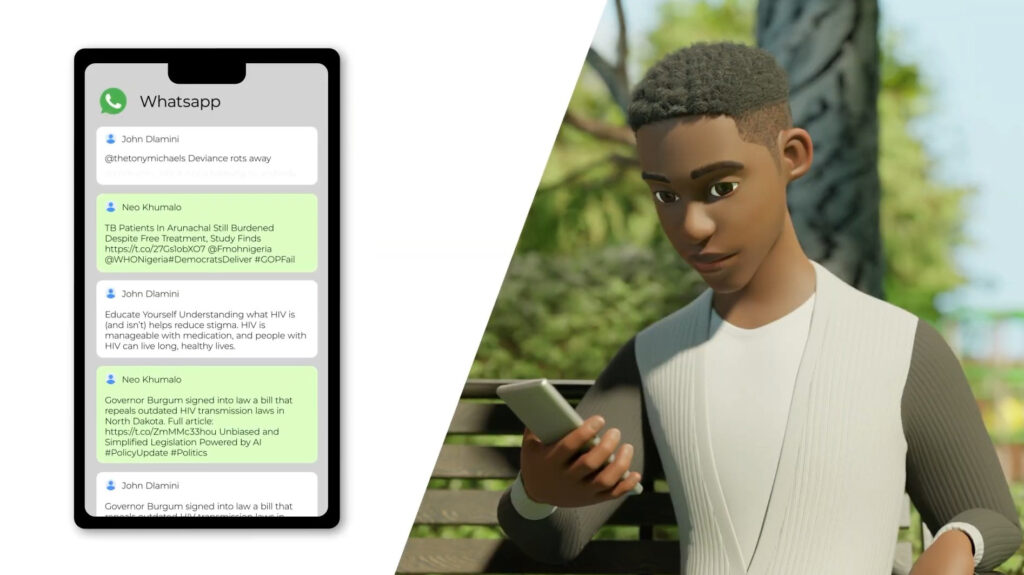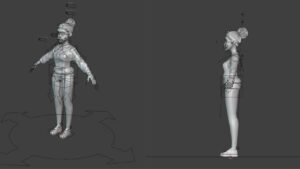The challenge was to take an urgent and complex issue, health misinformation, and present it in a way that was accessible to both professionals and the public. They turned to 3D animation knowing it could simplify abstract concepts and bring them to life with clarity and impact.
Our 3D Animation Solution
We produced a two-and-a-half-minute 3D animation video titled Understanding Misinformation in Health. The animation used immersive visuals and dynamic storytelling to humanise the problem. Characters and environments depicted misinformation as something fast-moving and infectious, while visual metaphors made abstract ideas concrete and easy to understand. By combining relatability with accuracy, we delivered a video that was both engaging and educational.
Audience and Purpose
The 3D animation video targeted a broad audience: health professionals, policymakers, and the general public. Its purpose was to educate viewers about the dangers of misinformation while equipping them with practical tools to respond. By framing the issue through everyday conversations and digital scenarios, the video made a complex public health challenge relatable, memorable, and actionable.

The Production Process
Our journey began with briefing sessions to understand the client’s objectives. From there, we developed creative concepts, storyboards, and style frames that translated research into a narrative-driven format.
Once the concept was approved, our team:
- Scripted a clear storyline to guide the flow of information.
- Developed high-resolution 3D models of characters, environments, and supporting visuals.
- Rigged characters for expressive animation, ensuring gestures and facial expressions felt natural.
- Applied realistic texturing, shading, and lighting to balance credibility with clarity.
- Produced animatics to fine-tune pacing and transitions before moving into full production.
Throughout, we collaborated closely with them, incorporating feedback through multiple review rounds to ensure precision and alignment with their goals.

Technical Aspects
From a technical perspective, the production required precision at every stage:
- Rendering Efficiency: We optimised 3D assets, textures, and lighting setups to reduce processing time without compromising visual fidelity. Render settings were fine-tuned for efficiency, with test renders run at key milestones. Render layers and passes were used to streamline compositing while avoiding unnecessary re-renders.
- Lighting, Shading & Effects: Physically accurate shaders were used where realism was needed, complemented by custom materials for stylised sequences. Particle effects were simulated with attention to scale and motion, ensuring they integrated naturally into the environment while reinforcing the narrative.
- Multi-Platform Delivery: The 3D animation video was designed for flexibility across platforms. Aspect ratios were adapted for 16:9 (desktop and broadcast), 1:1 (social feeds), and 9:16 (mobile). Compression settings were carefully balanced to ensure smooth playback across devices without sacrificing clarity.
- Compositing & Colour Correction: All render passes were composited to maximise control over lighting, textures, and effects. Colour grading enhanced visual consistency with the brand palette, while subtle refinements in glow, depth of field, and motion blur elevated the cinematic feel.
- Final Outputs: Deliverables included MP4 (H.264/H.265) for web and social, MOV (ProRes) for broadcast, and high-resolution stills. Standard resolutions included Full HD (1920×1080) and 4K, with optimised exports for vertical and square formats tailored to specific campaigns.
- Revision Workflow: After presenting the first draft, structured client feedback was gathered and addressed through round-based revisions. This ensured changes were managed efficiently, avoiding scope creep while keeping the client closely involved until final approval.
Artistic Design
Our creative team developed 3D character models for John and Neo that felt warm and relatable, allowing viewers to see themselves in the story. The environments were stylised yet grounded in reality, creating a balance between credibility and visual appeal. Strategic use of colour guided emotions throughout the narrative: bold red tones for misinformation, cooler palettes for clarity and facts. Subtle camera movements and transitions added flow, while typography and infographics reinforced key takeaways without disrupting the story.

Rendering and Post-Production
The final stage focused on refinement. High-resolution renders were produced and optimised for both desktop and mobile use. Post-production included precise colour correction, audio balancing, and final compositing to unify all visual layers. Sound design played a central role, professional narration was supported by subtle background music and carefully placed effects to enrich tone and pacing.
Deliverables were prepared in multiple formats and aspect ratios, enabling them to deploy the animation across websites, presentations, and social campaigns with maximum reach and impact.
The Final Impact
This project demonstrated how 3D animation can transform complex public health challenges into accessible and engaging narratives. By combining technical precision with creative storytelling, we delivered a polished, versatile video that exceeded expectations. The final animation not only reinforced the mission of combating health misinformation but also showcased the power of 3D animation as a tool for education, awareness, and impact.

We are a leading video production company in Johannesburg and have one of the top learner management systems in South Africa.
We specialise in Video Production, Photography, Graphic Design, eLearning Development, Web Design, Animation and Creative Consultation. | info@oliverkarstel.co.za | www.oliverkarstel.co.za | IG.com/oliverkarstel
No Comments